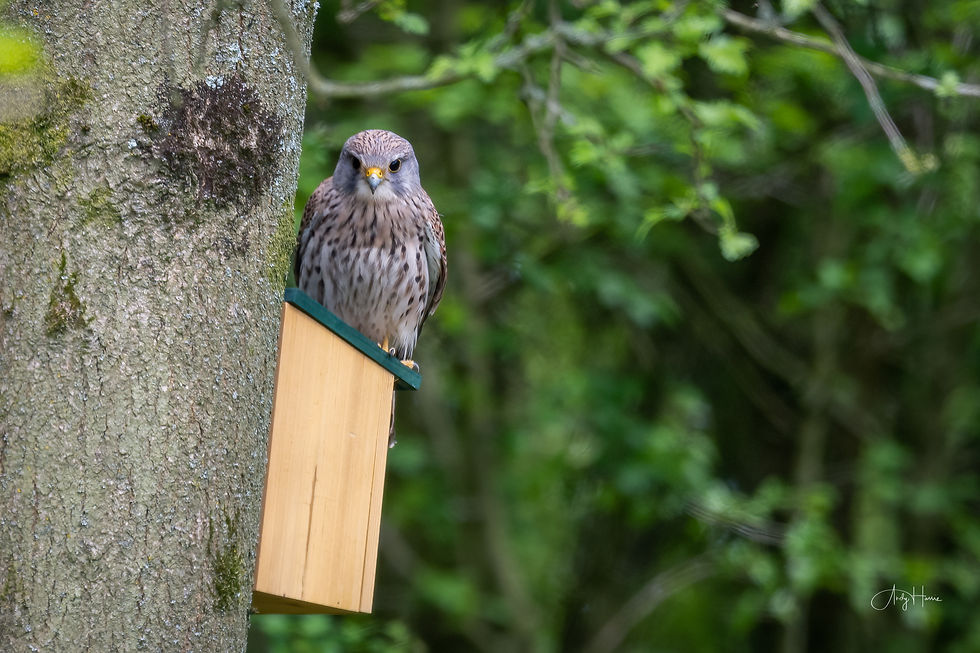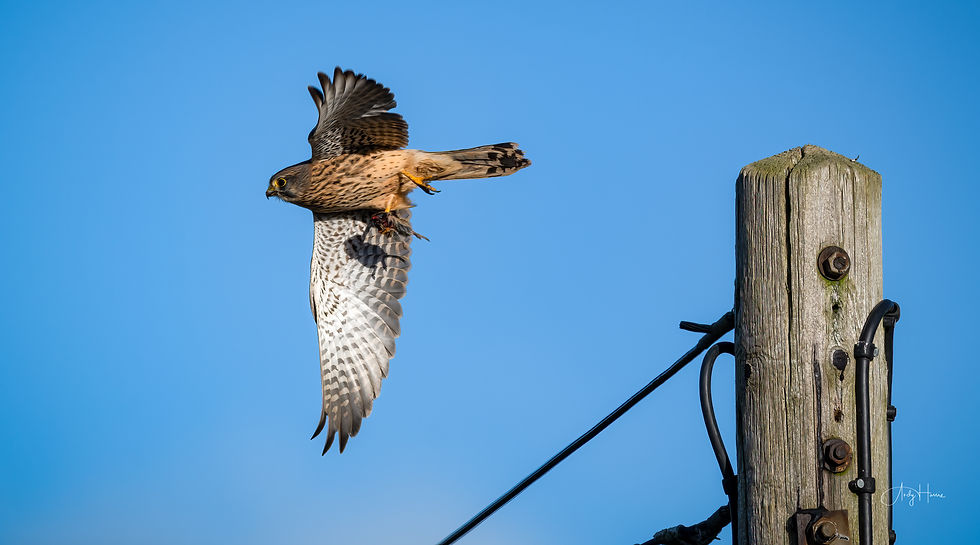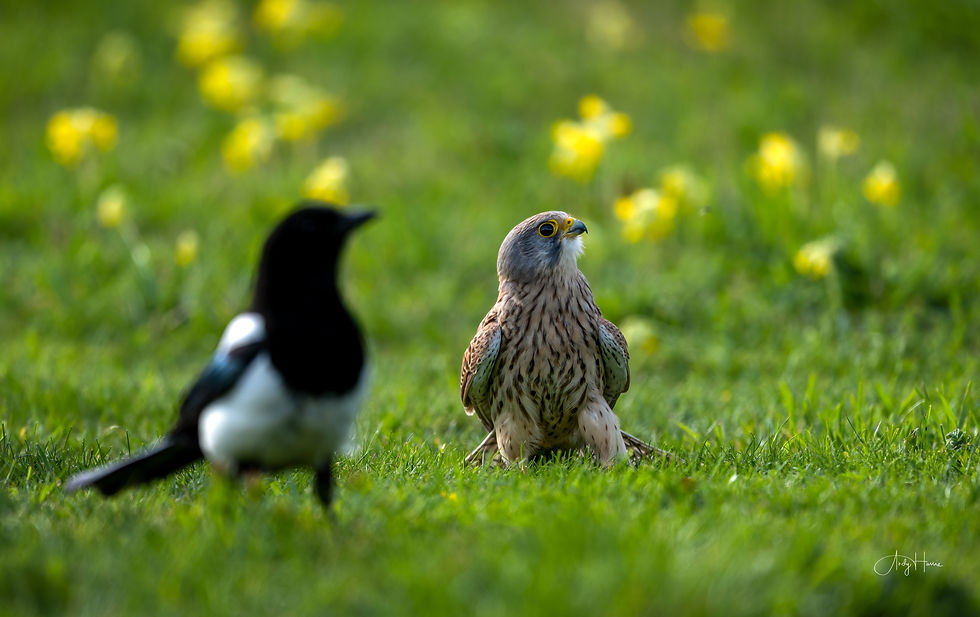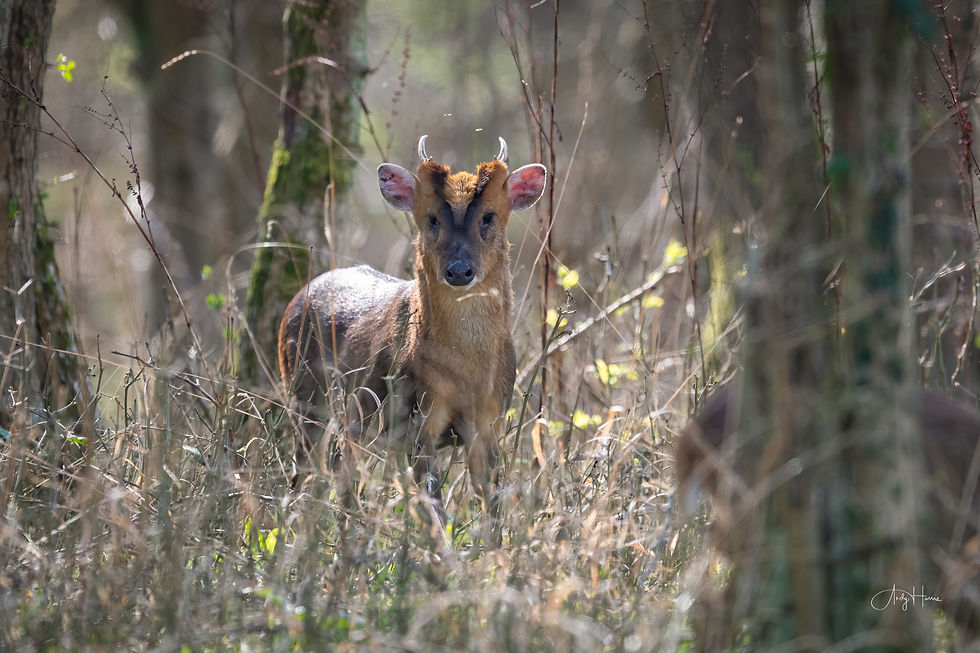A Kestrel at home and other visitors
- andyharris1
- May 29, 2022
- 4 min read

Some 'older' readers of my blog posts will no doubt remember the book and film "Kes'", featuring the beautiful story of how a young boy connects with a wild Kestrel.
More recently, Helen Macdonald's book 'H is for Hawk' captured the healing impact of a connection with a Goshawk had on the authors mental health when she was grieving for the loss of her Father.
The positive impact of time spent with wild things, is becoming recognised as an antidote to the stresses of modern living. Even a pretty relaxed, pretty much retired old chap with a lively mind, can benefit from some quiet time waiting for the arrival of the wild visitors to Harris Acres.
I've been watching a new Kestrel pair above our house and land here at Harris Acres, since Autumn 2021. I'm pretty sure that they have set up home within a few dozen metres of our house, down the wooded slopes that border our back garden overlooking the rolling Warwickshire countryside.
I've seen them hunting above and through our woodland, even stopping to checkout some of the bird boxes I installed this spring.


It's common to see the pair hovering above the tree line, watching for the voles and field mice scurrying in the undergrowth below.
I once caught sight of one of the pair hovering and then diving into the border of our garden, to emerge with a mouse or vole, perching on a telegraph pole to consume it's meal.

It's departure with meal in talons, gave me one of my favourite shots of recent times; the shadow of its prey outlined on the underside of its outstretched wing.

That sighting was followed by more regular visits from the pair, with our wildflower meadow a favourite hunting ground, populated as it is with a robust population of small voles, shrews and field mice.
I hatched a plan !
You can pay to visit hides set up to view and photograph Kestrels in action, tempted to visit by some supplementary feeding - a 'quid pro quo' deal that suits both hungry Kestrels AND wildlife photographers alike!
Perhaps I could set up something similar for 'our' Kestrels ... for free ... AND with zero carbon miles travel required!
Pop up tent hide placed under an an overhanging Hawthorn tree on the hedge line, a few potential perches and an old wooden gate placed c 20m away, some frozen (then thawed) mice (sold to feed raptors) and we were ready to go.
The biggest challenge was to keep the very clever, but pesky Magpies from taking the mice before the Kestrel could see them. Over time however, I noticed that a few loud handclaps and a shout would dissuade the clever Magpies, but leave the inquisitive Kestrel unperturbed.

What an absolute pleasure to sit and watch a Kestrel fly in to accept the supplementary food at close quarters. Kestrel numbers have fallen dramatically over the post was decades, so anything that supports their population has to be good. Kestrels need around 8 voles a day to survive and thrive, so a couple of mice or voles helps their food security.
The jury is out on whether the regular visitor is male or female, easy to distinguish in fully mature birds, however I believe 'our' bird is a first Summer juvenile male. I also hope that when I see 'him' disappearing back in the direction of where I believe the nest to be, that he's taking some food back to the female who is on eggs or feeding the young chicks with his catches.
Two adults and a few youngsters visiting would be an absolute joy, but in the meantime its great to see this bird filling his boots, sparring with the Magpies and giving aeronautical displays seemingly for my sole amusement!
Our Kestrel has become bold and although clearly spending most of its day in the skies above Warwickshire, it now hovers expectedly when I'm in the field, as if to say 'c'mon human, show me the mouse!" ha ha!


Kestrels are not the only regular visitors to Harris Acres as regular readers will know. Both Roe and Fallow Deer can be seen at dawn and dusk and Muntjac at just about any time of day. Here's a shot of a spring-timely frisky male, literally stamping the ground with his hooves to let me know he was there!

Some patiently diligent and regular supplementary winter feeding, has kept a pair of Foxes coming in to the grassy area in front of the house.
I've noticed that the smaller Fox (white tail tip and which I assume to be the Vixen) has stopped showing in late May, raising hopes that I may see Fox cubs again this year. This pair seem to have their cubs relatively late in the season, with the first sight of cubs coming in mid Summer last year rather than the more usual Spring showing. Fingers crossed they're on the same timetable this year - watch this space!
So that's the latest update on the WILD world here at home.
I'll finish with my favourite shot of my Kestrel friend, coming in to land and feed as a valued Dinner guest. Next Blogs will be full of Kingfishers and then the Puffins and wildlife to be found on a trip to stay on Skomer.
Keep your fingers crossed for Fox cubs and Kestrel youngsters in the meantime.
Thanks again to my blog readers.






















Comments